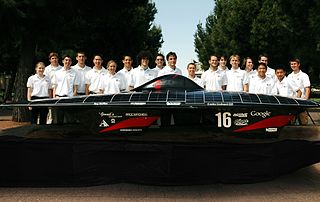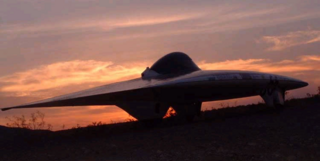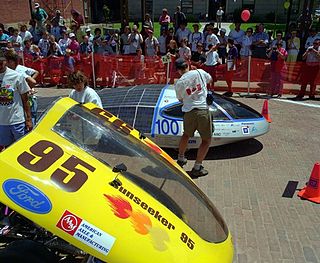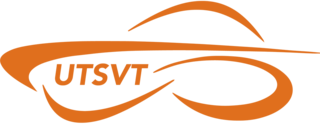
General Motors Company (GM) is an American multinational automotive manufacturing company headquartered in Detroit, Michigan, United States. The company is most known for owning and manufacturing four automobile brands, Chevrolet, GMC, Cadillac and Buick. By sales, it was the largest automaker in the United States in 2022, and was the largest in the world for 77 years before losing the top spot to Toyota in 2008.

The "General Motors EV1", often simplified to "GM EV1", is a battery electric car produced by the American automobile manufacturer General Motors. It was produced from 1996 until its demise in 1999, but the EV1 program ended four years later.

The American Solar Challenge (ASC), previously known as the North American Solar Challenge and Sunrayce, is a solar car race across the United States. In the race, teams from colleges and universities throughout North America design, build, test, and race solar-powered vehicles in a long distance road rally-style event. ASC is a test of teamwork, engineering skill, and endurance that stretches across thousands of miles of public roads.
Crowder College is a public community college in Neosho, Missouri. It serves the Community College District of Newton and McDonald counties in southwestern Missouri and other outlying areas. The school enrolled 3,864 in 2023.

The Stanford Solar Car Project (SSCP) is a student group at Stanford University that designs, builds, tests, and races solar-powered vehicles. The SSCP, a student-run, donation-funded organization, has been building and racing solar-powered vehicles since 1986. It has competed and placed at The World Solar Challenge, the Global Green Challenge, and American Solar Challenge.
Sunswift Racing is the solar car racing team of the University of New South Wales in Sydney, Australia. The team currently holds a number of world records and is best known for its participation in the World Solar Challenge (WSC). Since its founding in 1996 by Byron Kennedy, the Sunswift team has built a total of 7 cars, the most recent of which is Sunswift 7.

The University of Minnesota Solar Vehicle Project, or UMNSVP, is a team of undergraduate students from the University of Minnesota that designs and constructs solar-powered cars. In its 31 years, it has established itself as one of the world's top solar racing teams, and the top Cruiser/Multi-Occupant Vehicle team in the Western Hemisphere, with top-two finishes in eighteen of thirty-four events entered.

McGill University's Solar Car Team was composed of students from the faculties of Engineering and Computer Science. From 1990 - 2010, the team designed, built, tested and raced 3 generations of solar vehicles in international competitions. Under the brand Team iSun, the team placed 9th in the 2003 American Solar Challenge from Chicago to Los Angeles, and notably produced the lightest solar vehicle in the competition at 318 lbs. Through the production and racing of solar vehicles, the students on the team learn and exercise teamwork, personal initiative, and responsibility - not only in the engineering disciplines of design and analysis, but also in construction, marketing, project management, and promotion. Team members make an effort to promote engineering and computer science careers in their frequent meetings with elementary school, high school, and CEGEP students.
PrISUm Solar Car is the multidisciplinary student-run solar car racing team from Iowa State University that designs and builds solar powered vehicles to compete in the American Solar Challenge (ASC). The club was founded in 1989 by a group of engineering honor students from Tau Beta Pi and was simply known as the ISU Solar Car Project. In 1990, the team adopted the name of its first car, PrISUm.
The Sunraycer was a solar-powered race car designed to compete in the World Solar Challenge, the world's first race featuring solar-powered cars. The Sunraycer was a joint collaboration between General Motors, AeroVironment, and Hughes Aircraft.

The 1993 Maize & Blue solar car was built by the University of Michigan Solar Car Team during the period from 1990 to 1993.

The Chevrolet Volt is a plug-in hybrid car that was manufactured by General Motors, and also marketed in rebadged variants as the Holden Volt in Australia and New Zealand and the Buick Velite 5 in China, and with a different fascia as the Vauxhall Ampera in the United Kingdom and as the Opel Ampera in the remainder of Europe. Volt production ended in February 2019.

A solar car is a solar vehicle for use on public roads or race tracks. Solar vehicles are electric vehicles that use self-contained solar cells to provide full or partial power to the vehicle via sunlight. Solar vehicles typically contain a rechargeable battery to help regulate and store the energy from the solar cells and from regenerative braking. Some solar cars can be plugged into external power sources to supplement the power of sunlight used to charge their battery.
Solar car racing refers to competitive races of electric vehicles which are powered by solar energy obtained from solar panels on the surface of the car. The first solar car race was the Tour de Sol in 1985 which led to several similar races in Europe, US and Australia. Such challenges are often entered by universities to develop their students' engineering and technological skills, but many business corporations have entered competitions in the past. A small number of high school teams participate in solar car races designed exclusively for high school students.

The Midnight Sun Solar Rayce Car Team is a Canadian solar car race team affiliated with the University of Waterloo of Waterloo, Ontario. Founded in 1988, the Midnight Sun team is a student-run organization which designs and builds a solar vehicle every two to three years to compete in two solar challenges; the World Solar Challenge, held in Australia, and the American Solar Challenge, held in the United States.

The Sunseeker Solar Car Project, Sunseeker for short, is Western Michigan University's solar car team. Each vehicle is designed, built, maintained, and raced by students. Sunseeker has competed in all of the American Solar Challenge events, going back to 1990.

Blue Sky Solar Racing is a student-run team at the University of Toronto that designs and constructs solar powered vehicles to race in international competitions.
The Mizzou Hydrogen Car Team designs, builds and competes with an Urban Concept hydrogen fuel cell vehicle run by students at the University of Missouri in Columbia, Missouri. They recently competed with their vehicle named "Tigergen III" in the 2013 Shell Eco-Marathon. At the competition they achieved 8.8 mi/kWh which placed them 3rd in the UrbanConcept Hydrogen category. The team also won an off-track award for "Best Team Spirit"

The University of Texas Solar Vehicles Team (UTSVT) is a student-driven effort to design, build, test, and race solar vehicles for the purpose of reinforcing skills learned in the classroom, raising awareness of solar power, and bringing solar power closer to practicality. To accomplish this task, a multidisciplinary group of students from various disciplines in the Cockrell School of Engineering, and from other schools across the University of Texas, such as the College of Liberal Arts and the College of Natural Sciences come together to design and construct the most efficient vehicle as possible.

The Formula Sun Grand Prix (FSGP) is an annual solar-car race that takes place on closed-loop race tracks. In the race, teams from colleges and universities throughout North America design, build, test, and race solar-powered vehicles.



























